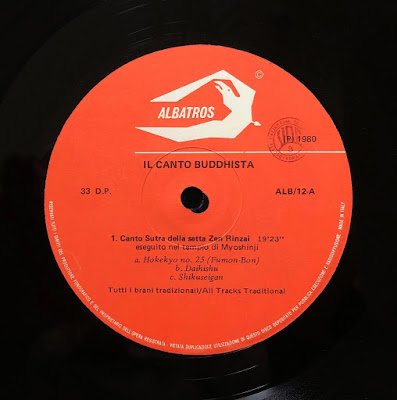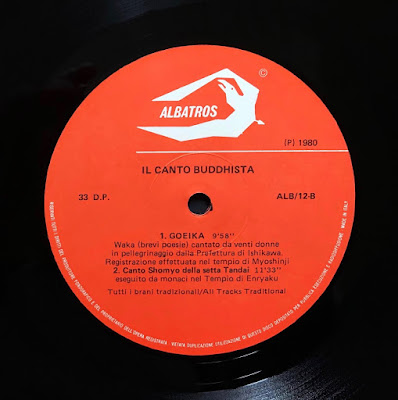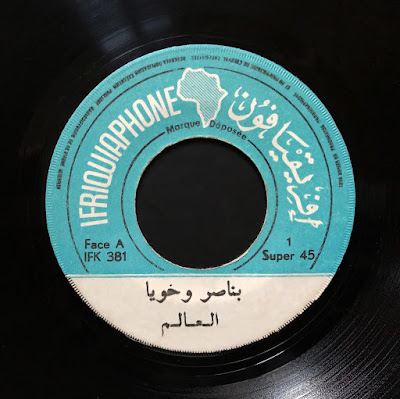INDIA – INDE
Faiyaz Khan – Raag Darbari / Raag Lalit / Raag Bhairavi – Hindusthan Record – LH 5, released 1962 (7 in, 45 RPM)
The Agra Gharana vocalist Ustad Faiyaz Khan (1886-1950) was a towering Hindustani artist of the 20th century. Born into a family of distinguished musicians in Sikandra, Agra, his father, Safdar Hussain Khan, died before he was born, so his grandfather, Ghulam Abbas Khan, and granduncle, Kallan Khan, supervised his musical upbringing. Khan was also much influenced by Zohrabai (1868-1913), another Agra Gharana singer, and greatly admired Abdul Karim Khan (1872-1937), the founder of Kirana Gharana.
Faiyaz Khan served as a court musician in Baroda, but also performed publicly in Bombay, Delhi, Lucknow and Calcutta, most notably at the All Bengal Music Conference launched in 1934. All India Radio broadcast his music throughout the country.
A true musical phenomenon, Faiyaz Khan expressed his incomparable versatility, brilliance and majesty in the Khayal style, as well as in the Dhrupad, Dhamar and Thumri styles.
According to Susheela Misra, author of Great Masters of Hindustani Music (1981): "As one of the privileged few in whose home the Aftab-e-Mausiqui [the Sun of Music] gave several informal all-night music soirees, I am at a loss for words when I try to describe the spellbinding effect of his voice: rich, masculine, sonorous, trembling with emotion, a voice capable of a thousand nuances and shades, moods and fancies, turns and twists that touched the very chords of the listeners' hearts. His voice was at its grandest in the mandra [lower] notes. Its range was not wide, in fact, it was quite limited in the taar saptak [higher octaves], but in his two or two and a half octave range he created 'a living picture of the raga, pulsating with life and personality.’"
Khan was also a prolific composer and great teacher, whose illustrious disciples included Vilayat Hussain Khan (1895–1962), Khadim Hussain Khan (1907–1993), Shrikrishna Narayan Ratanjankar (1900–1974), Latafat Hussain Khan (1920–1986), Dilip Chandra Vedi (1901–1992), Ata Hussain Khan (1899–1980), and Sharafat Hussain Khan (1930–1985).
Le chanteur d'Agra Gharana Ustad Faiyaz Khan (1886-1950) fut l'une des figures majeures de la musique Hindoustani du XXe siècle. Né dans une famille de grands musiciens à Sikandra, Agra, son père, Safdar Hussain Khan, meurt avant sa naissance, et son éducation musicale fut prodiguée par son grand-père, Ghulam Abbas Khan, et son grand-oncle, Kallan Khan. Faiyaz Khan fut également très influencé par la chanteuse d’Agra Gharana Zohrabai (1868-1913) et exprimait une grande admiration pour Abdul Karim Khan (1872-1937), le fondateur du Kirana Gharana.
Faiyaz Khan s’établit comme musicien de cour à Baroda, tout en donnant des récitals à Bombay, Delhi, Lucknow et Calcutta, notamment lors du All Bengal Music Conference crée en 1934. All India Radio diffusait également sa musique sur tout le territoire lui assurant une renommée nationale.
Véritable phénomène musical, Faiyaz Khan exprima toute l’étendue de sa puissante fluidité, sa brillance et sa majesté incomparables dans le Khayal, mais également dans le Dhrupad, le Dhamar et le Thumri.
Selon Susheela Misra, auteure de Great Masters of Hindustani Music (1981): « En tant que l'une des rares personnes privilégiées chez qui l'Aftab-e-Mausiqui [le Soleil de la musique] a animé plusieurs longues soirées musicales informelles nocturnes, je trouve difficilement les mots pour décrire l'effet envoûtant de sa voix: riche, masculine, sonore, vibrant d'émotion, une voix capable d’une myriade de couleurs et de nuances, des atmosphères et un univers onirique sophistiqués, et des rebondissements inattendus qui allaient droit au cœur des auditeurs. Sa voix atteint la plénitude dans les notes mandra [basses]. Sa tessiture de voix était en fait limitée dans le taar saptak [octaves supérieurs], mais dans ce registre de deux octaves et demi, il créa une image vivante du raga, débordant de vie et de personnalité. »
Khan fut également un compositeur prolifique et un grand guru qui forma d’illustres disciples tels Vilayat Hussain Khan (1895–1962), Khadim Hussain Khan (1907–1993), Shrikrishna Narayan Ratanjankar (1900–1974), Latafat Hussain Khan (1920–1986), Dilip Chandra Vedi (1901–1992), Ata Hussain Khan (1899–1980) et Sharafat Hussain Khan (1930–1985).
A1 - Fulwan ki Gendan Maika Na Maro - Raga Jaunpuri / फुलवन की गेदंद मैका, न मारो-जौनपुरी
A2 - Darbari Khyal / दरबारी ख्याल
B1 - Tarapat Hun Jaysey Jal Bin Meen - Raga Lalit / तडपत हूं जैसे जल बिन मीन - राग ललित
B2 - Chala Kaheko Jhooti Banawo – Bhairavi / चलो काहे को झूटी बनाओ - भैरवी
Atta Hussain Khan is the accompanying vocalist in these 1930s or 1940s recordings
(thanks Karun Kian for his input; listen to his excellent archival music selection: https://www.youtube.com/channel/UCGJiHl0c3TYybU-BgipaiAA).
Download
The cover of this record was designed by South-Indian classical dancer and teacher Amala Devi.
Our other male Hindustani vocal shares:
Faiyaz Khan, Abdul Karim Khan, Bade Ghulam Ali Khan, etc. – EALP 1453/1452 here
Amir Khan – Inreco 24110001 here
Bhimsen Joshi – ECLP 2264 here
Nasir Aminudin Dagar – EASD 1420 here
Photographs below are from The Art of Tantra by Philip Rawson, Thames & Hudson, 1978, and Miniatures et Peintures Indiennes by Roselyne Hurel, BnF Edition, 2010.
Simurgh, a mythical bird of Persian origin, clutches nine elephants, symbolic of the lower elements of the partial self, Kangra, 19th century:
Goddess Durga mounted on a chimera, Murshidabad, c. 1760.
Please help me purchase important traditional records to pursue my global
curation project and share the best finds with you on this blog:

























